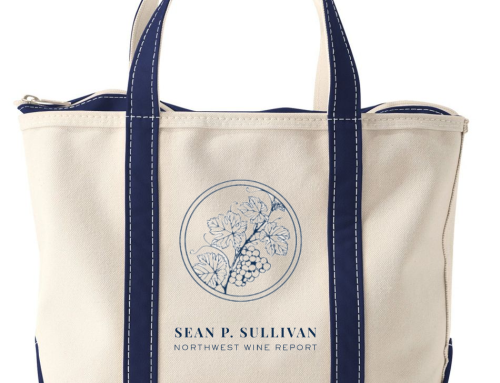
Hogue’s decision to move its production entirely to screwcaps was firmly rooted in science. The company first began seriously looking at alternative closures in 2001. At the time, the winery began a three year study comparing cork, synthetic closures, and screwcaps. Based on this study the winery moved 70% of its production to Saranex-lined screwcaps, starting in 2004. Hogue left its remaining wines in cork pending further study.
Hogue began its second study in 2005. The purpose was both to further validate the earlier findings and to evaluate the effects of different closure types on oxygen ingress, fruit preservation, and the ability to age.
First the winery looked at an oxygen-sensitive wine, Sauvignon Blanc. Here Hogue looked at 10 different closure types – seven different types of screwcaps and three different types of synthetic corks. Wines were tasted blind every four months for two years by a seven member tasting panel.
What the winery found was that wines sealed with a Saranex-lined screwcap better retained fresh aromas and flavors compared to the other closure types. The winery also found that not all screwcaps were created equal. Aluminum-lined screwcaps had flinty characteristics. Closures that let in very low amounts of oxygen had more reductive qualities, and ones that let in higher amounts of oxygen showed more aged characteristics.
Next the winery compared two Merlots – the 2003 Genesis Merlot ($15) and the 2004 Hogue Merlot ($9). Here the winery used nine different closures including: natural cork, five different types of screwcaps, and three different synthetic closures. Wines were tasted blind every 12 months for five years using a seven person tasting panel. Wines were subsequently evaluated on a number of different sensory criteria.
What the winery found was that, after five years, the 2003 Genesis Merlot using a Saranex-lined screwcap showed more fruit intensity compared to other closure types. This closure preserved the wine better than natural corks and synthetics but also did so appropriate for the wine’s age. Interestingly, the winery found that the amount of nitrogen added to the headspace made a significant difference, with raters preferring wines without nitrogen added. Fairly similar results were found for the 2004 Hogue Merlot.
Based on its study, the winery concluded screwcaps can be as good or better at both preserving wines and aging wine. As a result the winery plans to move the remainder of its production – Genesis and Reserve – to screwcap closures with Saranex linings starting with the 2009 vintage.
One interesting point from Hogue’s study is that there were large differences in various closures on how well the wine aged. Wines aged under certain closures were well preserved but still showed appropriate aged characteristics. Wines under different closures were not or did not.
This point was underscored by a blind tasting of its 2003 Genesis Merlot during the company’s recent presentation in Seattle. The tasting included five different closure types. The wines were markedly different with some extremely well preserved, some faded, and some in between.
For me, the wine that I most preferred was the Saranex lined closure using nitrogen in the headspace. However, I preferred this wine largely because it had been essentially mummified, showing almost no age whatsoever compared to its counterparts. In contrast, the Saranex-lined closure without nitrogen in the headspace showed an appropriate amount of age but was still well preserved. Notably, the wine using a cork closure was identifiable as it had a slight ‘corkiness’ to it, although the wine was well-preserved.
Overall, the Hogue study is notable for its scientific rigor. The winery should also be commended for the openness with which it has shared its findings (go to www.twistopenhogue.com for additional information). This type of study takes an enormous amount of time and considerable cost. To wit, 3,200 different samples were used during the course of the study. Few wineries in Washington have the ability, financially or logistically, to pull something like this off.
Co-founder Gary Hogue said that while the cost of the study was substantial, there was a more important driving force in conducting the study. “If your name is on a product and it’s bad, it’s embarrassing,” Hogue said. Hogue also questioned how acceptable it is to have wines tainted by TCA, even if the overall level of cork taint is low. “When you go into a grocery store, how many sections have consumables that are tainted? One – the wine section.”
While Hogue is now committed to using screwcaps for 100% of its production, Director of Winemaking Co Dinn understands that it will still take other wineries – and consumers – additional convincing. “This is just a piece of the puzzle. It helps move the needle a little bit,” Dinn says.
Note: Read my most recent update on the number of corked wines I have had in 2011 here. Read Part I in a recent series about why I came to believe in alternative closures here; read Part II about the experience of six Washington wineries using alternative closures here; and read Part III, the closing argument on alternative closures, here.







I love screw caps and congratulate Hogue on a serious study of the situation.
We stopped in at Hogue last July to taste while touring Washington wine country. I purchased 3 bottles of reserve reds and all 3 were under Stelvin closures. All 3 are still aging in the cellar. I have no doubt when I do decide to open them they will taste as fantastic as the day I tasted them in Prosser. That along with no fear of cork taint is quite reassuring. The sound of a cracking twist cap just doesn't excite me as does the crisp pop of a nice cork though. Perhaps they can work on that next.
ibglowin, my personal hope is that they will cover the screwcaps with a wax seal so I can sit back and enjoy watching somms struggle to open them. ;)